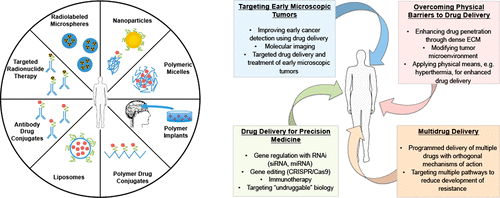当前位置:
X-MOL 学术
›
Mol. Pharmaceutics
›
论文详情
Our official English website, www.x-mol.net, welcomes your
feedback! (Note: you will need to create a separate account there.)
Drug Delivery in Cancer Therapy, Quo Vadis?
Molecular Pharmaceutics ( IF 4.5 ) Pub Date : 2018-03-19 00:00:00 , DOI: 10.1021/acs.molpharmaceut.8b00037 Zheng-Rong Lu 1 , Peter Qiao 1
Molecular Pharmaceutics ( IF 4.5 ) Pub Date : 2018-03-19 00:00:00 , DOI: 10.1021/acs.molpharmaceut.8b00037 Zheng-Rong Lu 1 , Peter Qiao 1
Affiliation

|
The treatment of malignancies has undergone dramatic changes in the past few decades. Advances in drug delivery techniques and nanotechnology have allowed for new formulations of old drugs, so as to improve the pharmacokinetics, to enhance accumulation in solid tumors, and to reduce the significant toxic effects of these important therapeutic agents. Here, we review the published clinical data in cancer therapy of several major drug delivery systems, including targeted radionuclide therapy, antibody–drug conjugates, liposomes, polymer–drug conjugates, polymer implants, micelles, and nanoparticles. The clinical outcomes of these delivery systems from various phases of clinical trials are summarized. The success and limitations of the drug delivery strategies are discussed based on the clinical observations. In addition, the challenges in applying drug delivery for efficacious cancer therapy, including physical barriers, tumor heterogeneity, drug resistance, and metastasis, are discussed along with future perspectives of drug delivery in cancer therapy. In doing so, we intend to underscore that efficient delivery of cancer therapeutics to solid malignancies remains a major challenge in cancer therapy, and requires a multidisciplinary approach that integrates knowledge from the diverse fields of chemistry, biology, engineering, and medicine. The overall objective of this review is to improve our understanding of the clinical fate of commonly investigated drug delivery strategies, and to identify the limitations that must be addressed in future drug delivery strategies, toward the pursuit of curative therapies for cancer.
中文翻译:

癌症治疗中的药物输送,是吗?
在过去的几十年中,恶性肿瘤的治疗发生了翻天覆地的变化。药物递送技术和纳米技术的进步已允许使用新的旧药物制剂,以改善药代动力学,增强实体瘤中的蓄积,并降低这些重要治疗剂的显着毒性作用。在这里,我们回顾了几种主要药物递送系统在癌症治疗中发表的临床数据,包括靶向放射性核素治疗,抗体-药物结合物,脂质体,聚合物-药物结合物,聚合物植入物,胶束和纳米颗粒。总结了这些递送系统在临床试验各个阶段的临床结果。根据临床观察结果讨论了药物输送策略的成功与局限。此外,讨论了将药物输送应用于有效的癌症治疗所面临的挑战,包括物理障碍,肿瘤异质性,耐药性和转移,以及在癌症治疗中药物输送的未来前景。通过这样做,我们打算强调将癌症治疗剂有效地递送至实体恶性肿瘤仍然是癌症治疗中的主要挑战,并且需要一种多学科的方法来整合来自化学,生物学,工程学和医学等各个领域的知识。这篇综述的总体目标是增进我们对常用研究的药物输送策略的临床命运的了解,并确定在未来的药物输送策略中必须寻求解决的局限性,以寻求治愈性的癌症治疗方法。包括物理障碍,肿瘤异质性,耐药性和转移在内,还讨论了癌症治疗中药物输送的未来前景。通过这样做,我们打算强调将癌症治疗剂有效地递送至实体恶性肿瘤仍然是癌症治疗中的主要挑战,并且需要一种多学科的方法来整合来自化学,生物学,工程学和医学等各个领域的知识。这篇综述的总体目标是增进我们对常用研究的药物输送策略的临床命运的了解,并确定在未来的药物输送策略中必须寻求解决的局限性,以寻求治愈性的癌症治疗方法。包括物理障碍,肿瘤异质性,耐药性和转移在内,还讨论了癌症治疗中药物输送的未来前景。通过这样做,我们打算强调将癌症治疗剂有效地递送至实体恶性肿瘤仍然是癌症治疗中的主要挑战,并且需要一种多学科的方法来整合来自化学,生物学,工程学和医学等各个领域的知识。这篇综述的总体目标是增进我们对常用研究的药物输送策略的临床命运的了解,并确定在未来的药物输送策略中必须寻求解决的局限性,以寻求治愈性的癌症治疗方法。讨论了癌症治疗中药物输送的未来观点。通过这样做,我们打算强调将癌症治疗剂有效地递送至实体恶性肿瘤仍然是癌症治疗中的主要挑战,并且需要一种多学科的方法来整合来自化学,生物学,工程学和医学等各个领域的知识。这篇综述的总体目标是增进我们对常用研究的药物输送策略的临床命运的了解,并确定在未来的药物输送策略中必须寻求解决的局限性,以寻求治愈性的癌症治疗方法。讨论了癌症治疗中药物输送的未来观点。通过这样做,我们打算强调将癌症治疗剂有效地递送至实体恶性肿瘤仍然是癌症治疗中的主要挑战,并且需要一种多学科的方法来整合来自化学,生物学,工程学和医学等各个领域的知识。这篇综述的总体目标是增进我们对常用研究的药物输送策略的临床命运的了解,并确定在未来的药物输送策略中必须寻求解决的局限性,以寻求治愈性的癌症治疗方法。并且需要一种多学科的方法来整合来自化学,生物学,工程学和医学等各个领域的知识。这篇综述的总体目标是增进我们对常用研究的药物输送策略的临床命运的了解,并确定在未来的药物输送策略中必须寻求解决的局限性,以寻求治愈性的癌症治疗方法。并且需要一种多学科的方法来整合来自化学,生物学,工程学和医学等各个领域的知识。这篇综述的总体目标是增进我们对常用研究的药物输送策略的临床命运的了解,并确定在未来的药物输送策略中必须寻求解决的局限性,以寻求治愈性的癌症治疗方法。
更新日期:2018-03-19
中文翻译:

癌症治疗中的药物输送,是吗?
在过去的几十年中,恶性肿瘤的治疗发生了翻天覆地的变化。药物递送技术和纳米技术的进步已允许使用新的旧药物制剂,以改善药代动力学,增强实体瘤中的蓄积,并降低这些重要治疗剂的显着毒性作用。在这里,我们回顾了几种主要药物递送系统在癌症治疗中发表的临床数据,包括靶向放射性核素治疗,抗体-药物结合物,脂质体,聚合物-药物结合物,聚合物植入物,胶束和纳米颗粒。总结了这些递送系统在临床试验各个阶段的临床结果。根据临床观察结果讨论了药物输送策略的成功与局限。此外,讨论了将药物输送应用于有效的癌症治疗所面临的挑战,包括物理障碍,肿瘤异质性,耐药性和转移,以及在癌症治疗中药物输送的未来前景。通过这样做,我们打算强调将癌症治疗剂有效地递送至实体恶性肿瘤仍然是癌症治疗中的主要挑战,并且需要一种多学科的方法来整合来自化学,生物学,工程学和医学等各个领域的知识。这篇综述的总体目标是增进我们对常用研究的药物输送策略的临床命运的了解,并确定在未来的药物输送策略中必须寻求解决的局限性,以寻求治愈性的癌症治疗方法。包括物理障碍,肿瘤异质性,耐药性和转移在内,还讨论了癌症治疗中药物输送的未来前景。通过这样做,我们打算强调将癌症治疗剂有效地递送至实体恶性肿瘤仍然是癌症治疗中的主要挑战,并且需要一种多学科的方法来整合来自化学,生物学,工程学和医学等各个领域的知识。这篇综述的总体目标是增进我们对常用研究的药物输送策略的临床命运的了解,并确定在未来的药物输送策略中必须寻求解决的局限性,以寻求治愈性的癌症治疗方法。包括物理障碍,肿瘤异质性,耐药性和转移在内,还讨论了癌症治疗中药物输送的未来前景。通过这样做,我们打算强调将癌症治疗剂有效地递送至实体恶性肿瘤仍然是癌症治疗中的主要挑战,并且需要一种多学科的方法来整合来自化学,生物学,工程学和医学等各个领域的知识。这篇综述的总体目标是增进我们对常用研究的药物输送策略的临床命运的了解,并确定在未来的药物输送策略中必须寻求解决的局限性,以寻求治愈性的癌症治疗方法。讨论了癌症治疗中药物输送的未来观点。通过这样做,我们打算强调将癌症治疗剂有效地递送至实体恶性肿瘤仍然是癌症治疗中的主要挑战,并且需要一种多学科的方法来整合来自化学,生物学,工程学和医学等各个领域的知识。这篇综述的总体目标是增进我们对常用研究的药物输送策略的临床命运的了解,并确定在未来的药物输送策略中必须寻求解决的局限性,以寻求治愈性的癌症治疗方法。讨论了癌症治疗中药物输送的未来观点。通过这样做,我们打算强调将癌症治疗剂有效地递送至实体恶性肿瘤仍然是癌症治疗中的主要挑战,并且需要一种多学科的方法来整合来自化学,生物学,工程学和医学等各个领域的知识。这篇综述的总体目标是增进我们对常用研究的药物输送策略的临床命运的了解,并确定在未来的药物输送策略中必须寻求解决的局限性,以寻求治愈性的癌症治疗方法。并且需要一种多学科的方法来整合来自化学,生物学,工程学和医学等各个领域的知识。这篇综述的总体目标是增进我们对常用研究的药物输送策略的临床命运的了解,并确定在未来的药物输送策略中必须寻求解决的局限性,以寻求治愈性的癌症治疗方法。并且需要一种多学科的方法来整合来自化学,生物学,工程学和医学等各个领域的知识。这篇综述的总体目标是增进我们对常用研究的药物输送策略的临床命运的了解,并确定在未来的药物输送策略中必须寻求解决的局限性,以寻求治愈性的癌症治疗方法。











































 京公网安备 11010802027423号
京公网安备 11010802027423号